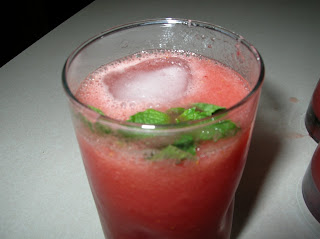Monday, July 07, 2008
Watermelon Strawberry Lemonade
I made a nice watermelon strawberry lemonade. Pictures shown above. It is an interesting twist on just plain regular strawberry lemonade. I used two cups of diced watermelon, one cup of sliced strawberries, 2 tbs sugar, half cup lemon juice. (I like it a little tart, if you like it sweeter increase the sugar). Blended everything with some ice. Added two cups of water to the mixture, and finally a garnish of mint leaves.
Tuesday, May 13, 2008
Managing the layout of figures in Latex
The placement of figures in your Latex document can sometimes be painful. I have recently started using the tabular environment to manage the layout of my figures in Latex documents. The idea is similar to using tables to manage layouts in html documents (before the popularity of CSS).
Here is an example:
Option 1:
The above will result in a two-column layout for the sub-parts of a figure. An easier alternative is not to have the nesting in the tabular environment and just have the following.
Option 2:
When the sub-figures are of the about the same size, option 2 works great. But when the sub-figures have different sizes and you want to align the figures a particular way then using option 1 gives more control. The other advantage of using Option 1 is that you can take the nesting of the tabular environment as far as you like. Consider this variation on option 1:
In the above example we have added two figures in the first column
while we just have a one figure in the second column. Note that this
same result can be achieved using \multirow and \multicolumn within
one tabular environment. The explicit tabular environment is more
intuitive for me and makes it easier to visualize and design the
layout.
Here is an example:
Option 1:
\begin{figure}
\begin{center}
\begin{tabular}[c]{cc}
\begin{tabular}[c]{c}
%% Put figure (a) here
\end{tabular} &
\begin{tabular}[c]{c}
%% Put figure (b) here
\end{tabular} \\
(a) & (b) \\
\end{tabular}
\end{center}
\end{figure}
The above will result in a two-column layout for the sub-parts of a figure. An easier alternative is not to have the nesting in the tabular environment and just have the following.
Option 2:
\begin{figure}
\begin{center}
\begin{tabular}[c]{cc}
%% Put figure (a) here
&
%% Put figure (b) here \\
(a) & (b) \\
\end{tabular}
\end{center}
\end{figure}
When the sub-figures are of the about the same size, option 2 works great. But when the sub-figures have different sizes and you want to align the figures a particular way then using option 1 gives more control. The other advantage of using Option 1 is that you can take the nesting of the tabular environment as far as you like. Consider this variation on option 1:
\begin{figure}
\begin{center}
\begin{tabular}[c]{cc}
\begin{tabular}[c]{c}
%% Put figure (a)_0 here & Put figure (a)_1 here \\
\end{tabular} &
\begin{tabular}[c]{c}
%% Put figure (b) here
\end{tabular} \\
(a) & (b) \\
\end{tabular}
\end{center}
\end{figure}
In the above example we have added two figures in the first column
while we just have a one figure in the second column. Note that this
same result can be achieved using \multirow and \multicolumn within
one tabular environment. The explicit tabular environment is more
intuitive for me and makes it easier to visualize and design the
layout.
Tuesday, May 06, 2008
My new webpage
I have a new webpage -- finally!!! Everything you ever wanted to know about me and more can be found in Neha Rungta's Official webpage .
Subscribe to:
Comments (Atom)




